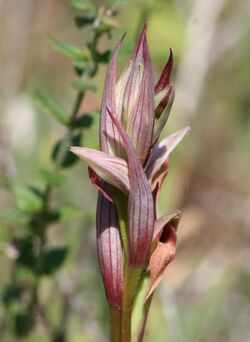Biology:Serapias parviflora
| Serapias parviflora | |
|---|---|

| |
| Inflorescence of Serapias parviflora | |
| Scientific classification | |
| Kingdom: | Plantae |
| Clade: | Tracheophytes |
| Clade: | Angiosperms |
| Clade: | Monocots |
| Order: | Asparagales |
| Family: | Orchidaceae |
| Subfamily: | Orchidoideae |
| Genus: | Serapias |
| Species: | S. parviflora
|
| Binomial name | |
| Serapias parviflora Parl.
| |
| Synonyms | |
| |
Serapias parviflora, the small-flowered tongue-orchid,[1] is a species of orchid native to the Mediterranean Basin and the Atlantic coast of Europe.
Description
Serapias parviflora grows to around 10–30 centimetres (4–12 in) high (occasionally up to 40 cm or 16 in). At the base of the stem, there are 4–7 keeled, linear leaves, and 1–3 bract-like leaves further up the stem. The 3–8 flowers (rarely up to 12) are arranged in a spike. The greyish-pink sepals and petals form a hood over the column and the lip, which is typically 14–19 mm (0.55–0.75 in) long.[2]
Distribution
Serapias parviflora is found natively across the Mediterranean Basin from the Iberian Peninsula to the Aegean Sea, as well as in the Canary Islands and along the Atlantic coast of France .[3] It was discovered in 1989 at Rame Head in Cornwall (United Kingdom ), and may have dispersed there naturally.[2] That colony disappeared after 20 years, but in 2021, fifteen plants were discovered in the 11th-floor roof garden of Nomura International's office building in the City of London.[4]
References
- ↑ (xls) BSBI List 2007, Botanical Society of Britain and Ireland, https://bsbi.org/download/3542/, retrieved 2014-10-17
- ↑ 2.0 2.1 Anne Harrap & Simon Harrap (2009). "Small-flowered tongue orchid, Serapias parviflora". Orchids of Britain and Ireland: a Field and Site Guide. A&C Black. pp. 314–316. ISBN 9781408127360. https://books.google.com/books?id=2qbg8pVrs6gC&pg=PT315.
- ↑ "Serapias parviflora Parl., sérapias à petites fleurs" (in fr). eFlore – fiches plantes. Tela Botanica. http://www.tela-botanica.org/bdtfx-nn-63203. Retrieved 2013-10-31.
- ↑ "Rare orchids found in City of London bank's rooftop garden". BBC News. 2021-06-15. https://www.bbc.com/news/uk-england-london-57439921.
External links
Wikidata ☰ Q1314770 entry
 |

